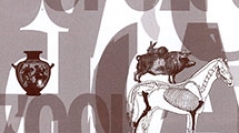

 Anthropozoologica
48 (2) - Pages 263-275
Anthropozoologica
48 (2) - Pages 263-275During the past decade, many archaeological interventions in southern Portugal have revealed a different panorama funerary practices dating from the 4th to the 2nd millennium BC. Besides the architectural specificities, contexts revealing nassociations of animal and human remains are multiplying. So far the available data reveal a preference for the deposition of domestic animals, on one hand; and for the deposition of animal parts rather than complete animals, on the other. The majority of the archaeological contexts under study revealed a preference for the deposition of articulated paws, isolated limb bones or even articulated animal parts, where the limbs are always present. The traditional explanations for such occurrences of animals in tombs are that they are the product of rituals of commensality. According to the anatomical representations and other contextual characteristics (e.g. direct associations of some animal bones with specific human bones, taphonomic history of the faunal collections), another interpretation is proposed. This approach is strongly guided by a new framework based on the understanding of Human/Animal relationships, where a bone or an anatomical part can be representative of a specific animal.
Recent Prehistory, funerary practices, animal bones, anatomical representation, Human/Animal relationship, Southern Portugal.